
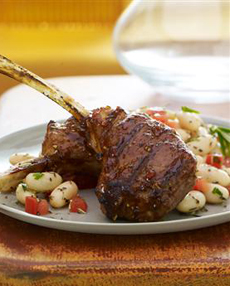 Instead of minimal-nutrient potatoes and white rice, serve energy- and protein-packed white beans. Get the recipe. Photo and recipe courtesy McCormickk.
June 2005
Last Updated March 2018
|
 |
Beans & Grains Glossary
Page 6: Terms With S ~ Z
Here are terms including quinoa plus navy, pinto and red beans. If you’d like to suggest additional words, use the Contact Us link on this page. See our 60 other food glossaries.
Click on a letter to go to the appropriate glossary page:
a b c d e f g h i j k l m n o p q r s t u v w x y z
This material is copyrighted and cannot be reproduced in whole or in part
without written permission. You are welcome to link toi it.
SCARLET RUNNER BEAN or RUNNER BEAN
The runner bean (Phaseolus coccineus, Fabaceae) is often called the scarlet runner bean because of its bright red flowers. The beautiful beans can be pink, purple, red and tan, accented with black. They look handsome on a plate or in a jar as kitchen decor.
SEMOLINA
Semolina is the gritty, coarse particles of wheat left after the finer flour has passed through a bolting machine, and is used to make pasta. Also known as rava in South India, an essential product in an Indian kitchen, called Indian semolina.
|
|
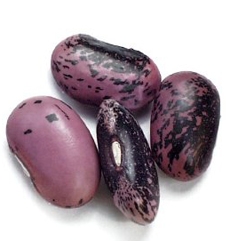
These beautiful runner beans are available on Amazon.com. |
|
SHELLING BEANS
Unlike green beans, which are eaten pod and all, the beans must be removed from the pods of shelling beans before the bean can be cooked or dried. Most shelling bean crops are harvested when the pods and beans inside are dry, then sold as a dried produc. But you can find some of these beans in farmers markets in the late summer and fall, still fresh. Examples are cannellini eans, cranberry beans, kidney beans.
SOOJI
See farina.
|
|
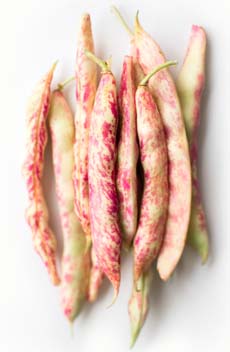
Cranberry beans, perhaps the prettiest shelling bean pod. Photo courtesy Good Eggs. |
SORGHUM
Sorghum is a cereal grain that grows tall like corn, and has long been grown in the South. It grows tall in the field, like corn. It is has been primarily used for livestock feed and ethanol. But for centuries, it was made into sorghum syrup, a molasses substitute (molasses comes from sugar cane). Today it is being lauded, along with other “alternative grains,” as a food cereal. Here are ways to use sorghum for breakfast, lunch and dinner.
|
|
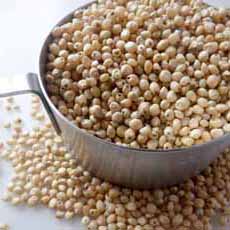
Photo courtesy Good Eggs.
|
SOY NUTS or ROASTED SOYBEANS
Soy nuts are whole soybeans that have been soaked in water and then baked. They are similar in texture to peanuts. Both are members of the legume (bean) family, Fabaceae. Soy nuts are enjoyed as snacks or to garnish salads or vegetable dishes; and are available plain or in a variety of flavors.
|
|
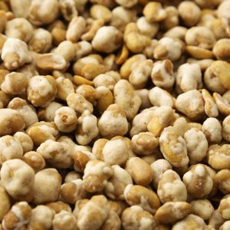
Wasabi-flavored soy nuts from Fastachi are available on Amazon.com. Photo courtesy Fastachi. |
TAPIOCA
Tapioca is a flavorless, colorless, odorless starch extracted from the root of the cassava plant. Gluten free, it is used worldwide as a thickening agent. The starch is processed into several forms: fine or coarse flakes or flour/meal, tiny round pearls, powder and rectangular sticks; the products are traditionally white, but sticks and pearls may be colored brown or vibrant pastels. The form most familiar to American consumers is white pearl tapioca. All forms except flour and powder must be soaked prior to cooking, to rehydrate them; they absorb water equal to twice their volume or more. In all forms, tapioca is opaque before cooking; after cooking it becomes translucent.
|
|
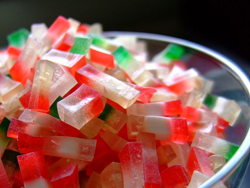
This looks like a bowl of tempting candies, but they’re flavorless, odorless tapioca sticks. Photo by Midori | Wikimedia. |
TEFF or ANNUAL BUNCH GRASS or LOVEGRASS
Eragrostis tef (Zucc.) Trotter is believed to have originated in Ethiopia between 4000 and 1000 B.C.E. Teff seeds were discovered in a pyramid thought to date back to 3359 B.C.E. The grain has been widely cultivated in Australia, Ethiopia and India. In Ethiopia, teff is grown primarily as a cereal crop, where it is ground into flour, fermented for three days then made into enjera (injera), a sourdough-type flat bread. It is also eaten as porridge and used as an ingredient of home-brewed alcoholic drinks. The grass is grown as forage for cattle and is also used as a component in adobe construction in Ethiopia. Teff is barely known in the U.S., although it is cultivated in South Dakota and Idaho and is available in many health food stores.
|
|
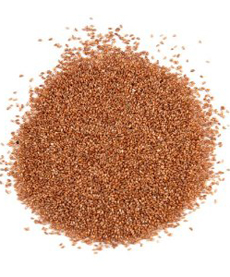
Teff is available at natural and health food stores, and online at Amazon.com. |
The word “teff” is thought to have been derived from the Ethiopian Amharic word teffa, which means lost—due to small size of the grain and how easily it can be lost if dropped. It is the smallest grain in the world, measuring only about 1/32 of an inch in diameter. It takes 150 grains of teff to weigh as much as one grain of wheat. Because the grains of teff are so small, the bulk of the grain consists of the bran and germ. This makes teff nutrient-dense (the bran and germ are the most nutritious parts of any grain). Teff is high in protein, carbohydrates and fiber. It has a very high calcium content and contains high levels of aluminum, barium, copper, iron, phosphorous and thiamin. It is full of amino acids, and has high lysine levels. It contains no gluten so it can be enjoyed by those with gluten intolerance.
URAD DAL or BLACK LENTILS or ULUTHAM PARUPPU
These black lentils are popular in India, used both whole and split. The black skin lends strong and earthy flavor to whole lentils, which are used in curries. When the lentils are split and skinned (becoming off-white in color), they are used for making dal or soups. Urad dal, along with rice, is used to make dosas, the crisp pancakes of southern India, and also to make papadums. In the south of India, urad dal is used as a seasoning with mustard seeds and for curries. These black lentils should not be confused with black beluga lentils.
|
|
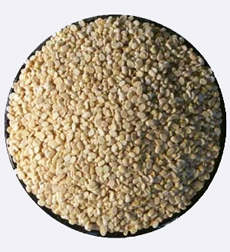
Urad dal is available at natural and health food stores, and online at Amazon.com. |
WHOLE GRAIN
Products made with the whole kernel or grain, which consists of three components: the bran, endosperm and germ. The bran (outer layer) contains the largest amount of fiber, the endosperm (middle layer) contains mostly protein and carbohydrates along with small amounts of B vitamins, and the germ (inner part) is a rich source of trace minerals, unsaturated fats, B vitamins, antioxidants and phytochemicals.
YANKEE BEAN
See navy bean.
Content researched from:

|


 Instead of minimal-nutrient potatoes and white rice, serve energy- and protein-packed white beans. Get
Instead of minimal-nutrient potatoes and white rice, serve energy- and protein-packed white beans. Get 





